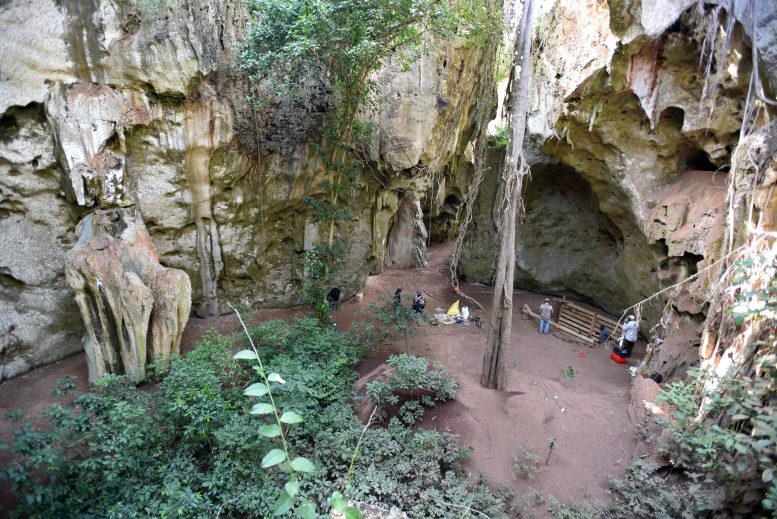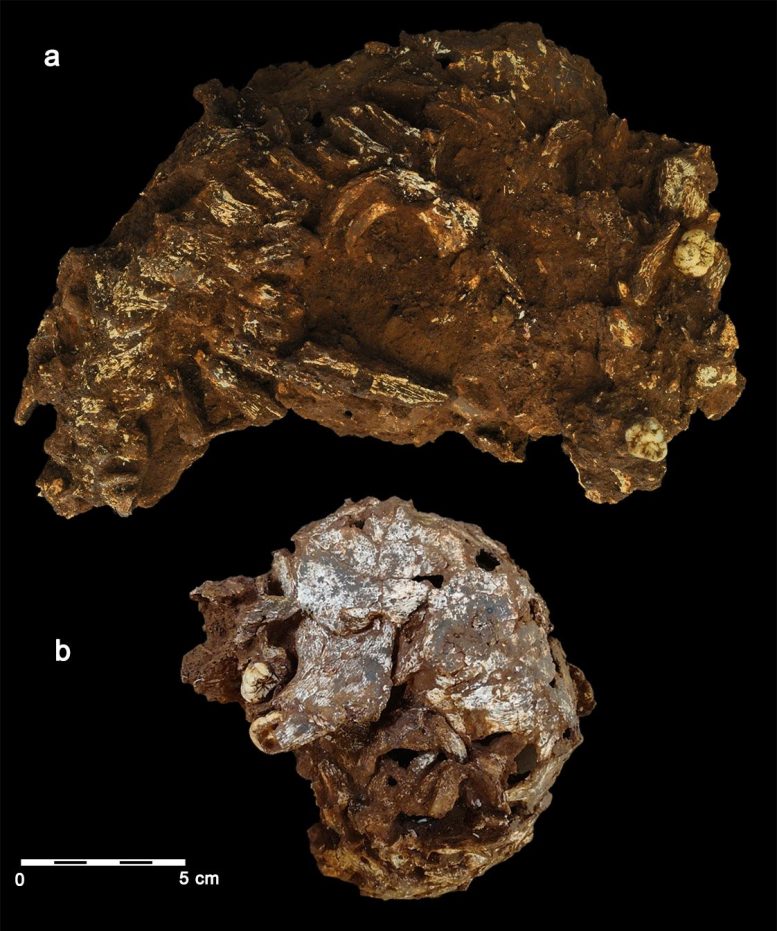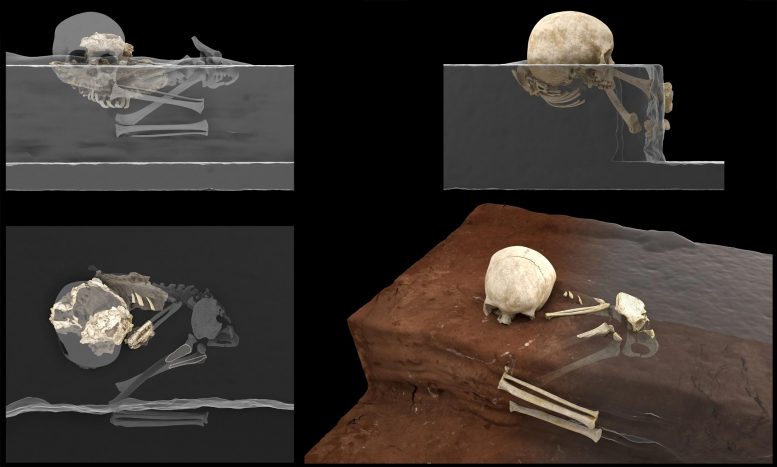
General view of the cave site of Panga ya Saidi. Note trench excavation where burial was unearthed. Credit: Mohammad Javad Shoaee
Dating to 78,000 years ago, the burial was found by archaeologists in Panga ya Saidi, a cave site on the Kenyan coast.
Despite being home to the earliest signs of modern human behavior, early evidence of burials in Africa is scarce and often ambiguous. Therefore, little is known about the origin and development of mortuary practices in the continent of our species’ birth. A child buried at the mouth of the Panga ya Saidi cave site 78,000 years ago is changing that, revealing how Middle Stone Age populations interacted with the dead.
Panga ya Saidi has been an important site for human origins research since excavations began in 2010 as part of a long-term partnership between archaeologists from the Max Planck Institute for the Science of Human History (Jena, Germany) and the National Museums of Kenya (Nairobi).
“As soon as we first visited Panga ya Saidi, we knew that it was special,” says Professor Nicole Boivin, principal investigator of the original project and director of the Department of Archaeology at the MPI for the Science of Human History. “The site is truly one of a kind. Repeated seasons of excavation at Panga ya Saidi have now helped to establish it as a key type site for the East African coast, with an extraordinary 78,000-year record of early human cultural, technological, and symbolic activities.”

External view of the Panga ya Saidi main block with the articulated partial skeleton (upper) and external view of the left side of Mtoto’s skull and mandible (below). Credit: Martinón-Torres, et al., 2021
Portions of the child’s bones were first found during excavations at Panga ya Saidi in 2013, but it wasn’t until 2017 that the small pit feature containing the bones was fully exposed. About three meters below the current cave floor, the shallow, circular pit contained tightly clustered and highly decomposed bones, requiring stabilization and plastering in the field.
“At this point, we weren’t sure what we had found. The bones were just too delicate to study in the field,” says Dr. Emmanuel Ndiema of the National Museums of Kenya. “So we had a find that we were pretty excited about — but it would be a while before we understood its importance.”
Human remains discovered in the lab
Once plastered, the cast remains were brought first to the National Museum in Nairobi and later to the laboratories of the National Research Center on Human Evolution (CENIEH) in Burgos, Spain, for further excavation, specialized treatment, and analysis.
Two teeth, exposed during initial laboratory excavation of the sediment block, led the researchers to suspect that the remains could be human. Later work at CENIEH confirmed that the teeth belonged to a 2.5- to 3-year-old human child, who was later nicknamed ‘Mtoto,’ meaning ‘child’ in Swahili.

Virtual reconstruction of the Panga ya Saidi hominin remains at the site (left) and ideal reconstruction of the child’s original position at the moment of finding (right). Credit: Jorge González/Elena Santos
Over several months of painstaking excavation in CENIEH’s labs, spectacular new discoveries were made. “We started uncovering parts of the skull and face, with the intact articulation of the mandible and some unerupted teeth in place,” explains Professor María Martinón-Torres, director at CENIEH. “The articulation of the spine and the ribs was also astonishingly preserved, even conserving the curvature of the thorax cage, suggesting that it was an undisturbed burial and that the decomposition of the body took place right in the pit where the bones were found.”
Microscopic analysis of the bones and surrounding soil confirmed that the body was rapidly covered after burial and that decomposition took place in the pit. In other words, Mtoto was intentionally buried shortly after death.
Researchers further suggested that Mtoto’s flexed body, found lying on the right side with knees drawn toward the chest, represents a tightly shrouded burial with deliberate preparation. Even more remarkable, notes Martinón-Torres, is that “the position and collapse of the head in the pit suggested that a perishable support may have been present, such as a pillow, indicating that the community may have undertaken some form of funerary rite.”
Burials in modern humans and Neanderthals
Luminescence dating securely places Mtoto’s at 78,000 years ago, making it the oldest known human burial in Africa. Later interments from Africa’s Stone Age also include young individuals — perhaps signaling special treatment of the bodies of children in this ancient period.
The human remains were found in archaeological levels with stone tools belonging to the African Middle Stone Age, a distinct type of technology that has been argued to be linked to more than one hominin species.
“The association between this child’s burial and Middle Stone Age tools has played a critical role in demonstrating that Homo sapiens was, without doubt, a definite manufacturer of these distinctive tool industries, as opposed to other hominin species,” notes Ndiema.
Though the Panga ya Saidi find represents the earliest evidence of intentional burial in Africa, burials of Neanderthals and modern humans in Eurasia range back as far as 120,000 years and include adults and high proportion of children and juveniles. The reasons for the comparative lack of early burials in Africa remain elusive, perhaps owing to differences in mortuary practices or the lack of field work in large portions of the African continent.
“The Panga ya Saidi burial shows that inhumation of the dead is a cultural practice shared by Homo sapiens and Neanderthals,” notes Professor Michael Petraglia of the Max Planck Institute in Jena. “This find opens up questions about the origin and evolution of mortuary practices between two closely related human species, and the degree to which our behaviors and emotions differ from one another.”
Reference: “Earliest known human burial in Africa” by María Martinón-Torres, Francesco d’Errico, Elena Santos, Ana Álvaro Gallo, Noel Amano, William Archer, Simon J. Armitage, Juan Luis Arsuaga, José María Bermúdez de Castro, James Blinkhorn, Alison Crowther, Katerina Douka, Stéphan Dubernet, Patrick Faulkner, Pilar Fernández-Colón, Nikos Kourampas, Jorge González García, David Larreina, François-Xavier Le Bourdonnec, George MacLeod, Laura Martín-Francés, Diyendo Massilani, Julio Mercader, Jennifer M. Miller, Emmanuel Ndiema, Belén Notario, Africa Pitarch Martí, Mary E. Prendergast, Alain Queffelec, Solange Rigaud, Patrick Roberts, Mohammad Javad Shoaee, Ceri Shipton, Ian Simpson, Nicole Boivin and Michael D. Petraglia, 5 May 2021, Nature.
DOI: 10.1038/s41586-021-03457-8









Be the first to comment on "Africa’s Oldest Human Burial Site Uncovered: 78,000-Year-Old Remains Reveal How Stone Age Populations Interacted With the Dead"